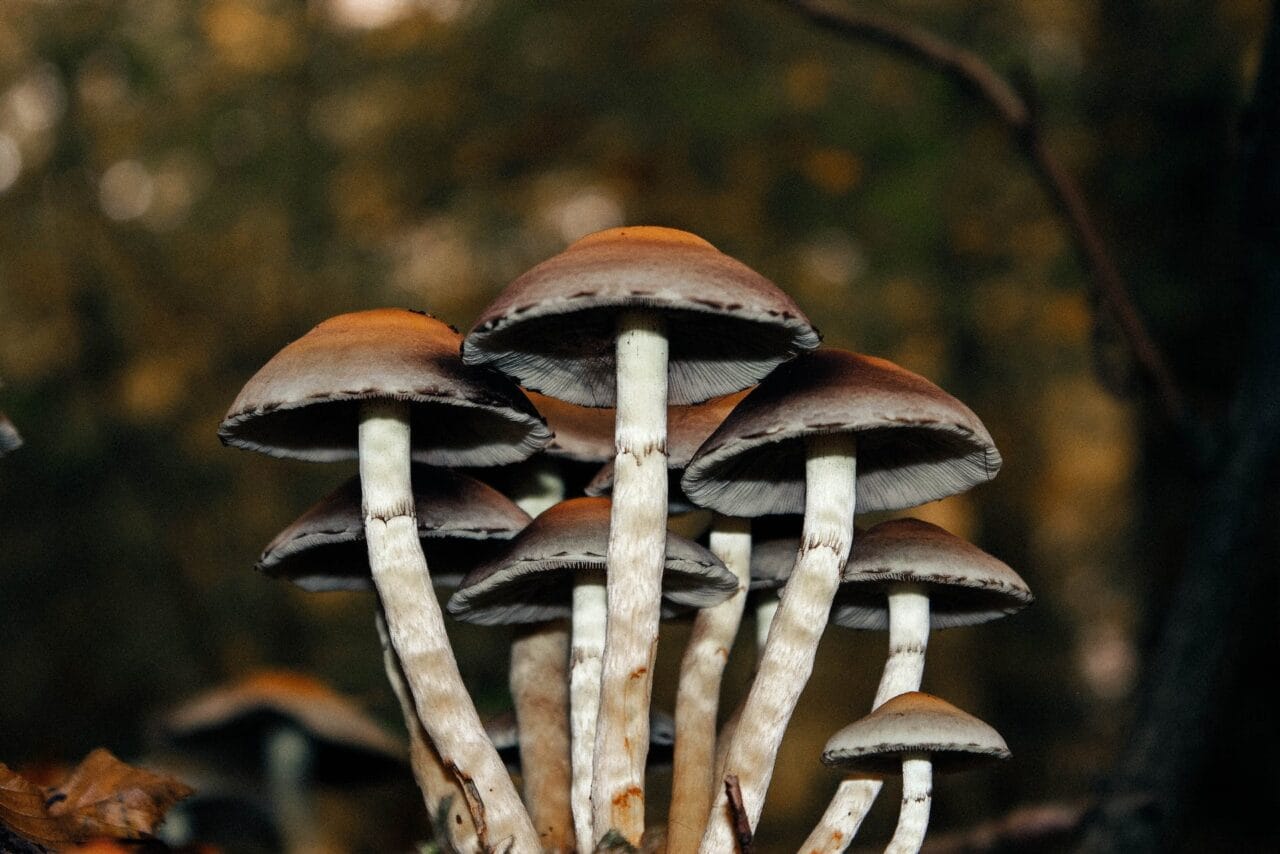Psilocybin, a psychoactive compound present in magic mushrooms, is often consumed for recreational purposes due to its ability to induce feelings of euphoria and hallucinations.
In addition to its mind-altering properties, research has been conducted into the potential benefits of this compound for the relief of chronic pain.
This article discusses a case study that investigates how microdosing mushrooms might assist in alleviating chronic pain.
Key Takeaways:
- Microdosing mushrooms has the potential to provide both immediate and lasting pain relief.
- Compared to traditional pain medications, microdosing psilocybin tends to have fewer side effects when given in small doses.
- Psilocybin engages with the serotonin 2A (5-HT2A) receptors, which can help alleviate pain among other conditions.

The Study
A study titled “Microdosing Psilocybin for Chronic Pain: A Case Series“, led by Dr. Matthew Lyes and his team from the Division of Pain Medicine in the Department of Anesthesiology at the University of California, San Diego, focused on three patients who self-administered small doses of psilocybin to manage their chronic pain symptoms.
Three Patients, Same Result – Chronic Pain Relief
Patient # 1
| AGE/ GENDER: | 37, Male |
| TYPE OF PAIN: | Neuropathic pain experienced below the site of a spinal cord injury. |
| PAIN LEVEL: | Starting at 4 to 5/ 10, increasing to 8/ 10 later in the day |
| PSILOCYBIN DOSE: | 250 mg of ground mushroom for less than 6 months |
| RESULT: | Discontinuation of prescribed pain medication, decreased muscle spasms, and improved bowel movement efficiency. No signs of rebound pain or withdrawal symptoms were observed. |
| The patient stated that while his usual medications only managed to dull the pain, psilocybin effectively eliminated it, reducing his average pain level from 5 to | |
Case Study: Second Patient
| AGE/GENDER: | 69-year-old Female |
| PAIN TYPE: | Complex Regional Pain Syndrome (CRPS) |
| PAIN INTENSITY: | Typically between 5 to 7 out of 10, but can increase with activity and during periods of heightened pain |
| PSILOCYBIN DOSAGE: | Daily dose of 500 mg for 7 to 10 days with rest periods (2 to 3 days) over a year. Dosage increases to 750 mg to 1 gram during periods of heightened pain |
| EFFECTS: | 80% reduction in pain for 3-4 hours, with pain levels returning to initial levels after 12 hours. Full pain relief (90%-100%) lasts 6-8 hours, returning to initial levels after 18 hours. |
| The patient notes a decrease in appetite without experiencing nausea. Disorientation or instability while walking is experienced when the dosage is increased (750 to 1000mg). | |
Case Study: Third Patient
| AGE/GENDER: | 40-year-old Female |
| PAIN TYPE: | Lumbar radiculopathy and neuropathic pain |
| PAIN INTENSITY: | 8 out of 10, rising to 10 out of 10 during physical activity |
| PSILOCYBIN DOSAGE: | 1000 mg from a mushroom chocolate bar every two months. |
| EFFECTS: | Significant pain relief without any psychoactive effects. Increased flexibility and functionality have been observed. Pain levels gradually return to initial levels over 2-4 weeks. Repeated dosing enhances control over pain. |
| The patient does not experience any noticeable physical, cognitive, or behavioural side effects. Her mood remains mostly consistent. She continues to take her regular dosage of an SSRI for depression management throughout the psilocybin treatment period. | |
Exploring Pain Management with Psilocybin
Persistent somatic and visceral pain signals strengthen specific neural paths due to peripheral and central sensitization, contributing to a chronic perception of pain, both physically and emotionally. Psychedelics such as psilocybin activate 5-HT2A receptors, potentially resetting brain areas associated with neuropathic conditions.
A patient reported pain relief lasting for weeks. This suggests that stimulating the 5-HT2A receptors directly can lead to central regulation of pain perception and
Neural adaptability.
Potential Side Effects: A Comparison between Psilocybin and Traditional Pain Relievers
| PSILOCYBIN (Based on Research) | TRADITIONAL PAIN RELIEVERS |
| Muscle spasms | Nausea |
| Decreased appetite | Stomach discomfort |
| Confusion | Headaches |
| Difficulty walking | Dependence |
| No mood changes | Drowsiness |
Future Research Prospects for Psilocybin
The researchers have identified several potential areas for further study, based on the experiences of the three subjects.
- Small psilocybin dosages may offer immediate and perhaps lasting relief from neuropathic pain, without leading to physical dependence or addiction.
- Research the combined effects of different treatment methods with psilocybin. For example, patient #3 reported enhanced pain relief when psilocybin was used in conjunction with physical therapy.
- As demonstrated in this case study, small psilocybin doses might provide pain relief even without psychotherapy. The researchers propose that the inclusion of therapeutic guidance might enhance or prolong the therapeutic effects.
Study Limitations
Despite the encouraging outcomes noticed in the subjects, it’s crucial to take into account the limitations identified in the study.
- The small sample size may not be representative of the entire population suffering from neuropathic pain.
- The study didn’t include any participants who didn’t respond to psilocybin.
- No pre and post-treatment assessments were conducted to evaluate the impact of psilocybin on psychiatric disorders like depression and anxiety.
- The majority of the data was self-reported by the subjects.
- The presence of the interviewer and potential biases related to psilocybin could have influenced the participants’ responses.
- The study didn’t assess the influence of the placebo effect.
- The study didn’t measure the psilocybin content in each mushroom.
Understanding Microdosing with Mushrooms
In this research, participants Patient #1 and Patient #2 consumed a microdose of psilocybin, which was derived from powdered, dry mushrooms. On the other hand, Patient #3 combined it with chocolate. There is a wide variety of products specially designed for psilocybin microdosing, which we have summarized below.
Dehydrated Mushrooms
Although the specific strain used in the study was not disclosed, the following strain is a suitable choice for those starting their journey.
- Golden Teacher: This is one of the most prevalent and recognized strains of magic mushrooms.
- Amazonian Cubensis: Known for its user-friendliness, it can offer cognitive enhancements.
- Cambodian: Microdosing with Cambodian cubensis mushrooms can augment concentration, social awareness, and mood elevation.
Microdose Capsules
- Euphoria Psychedelics – Micro Calm Capsules: This formulation includes Ashwagandha, Reishi, CBD, Valerian root, and Psilocybin Mushrooms, all of which have been scientifically shown to decrease anxiety and stress.
- Ground Sounds – Microdose Capsules – Champion Lover: This alluring blend provides three dosage options: 50mg, 100mg, or 250mg of pure psilocybin combined with reishi, cacao, cordyceps, and maca.
- Kind Stranger – Brighten Capsules 250mg: These capsules contain the Golden Teacher strain, renowned for promoting clarity, enhanced creativity, and improved focus.
The Use of Psilocybin for Pain Relief
While scientific studies on the analgesic properties of mushrooms are still in preliminary stages, anecdotal reports and small-scale case studies are showing promising results.
These instances underscore the urgency for more comprehensive research into the potential advantages of psilocybin, class=”wp-block-list”>
Especially in the sphere of managing persistent pain, psilocybin offers hope.
Even before its widespread acceptance for pain relief, the heartening stories from case studies offered solace and optimism to those battling chronic pain.
Frequently Asked Questions
What are the effects of microdosing psilocybin?
Psilocybin primarily activates a serotonin receptor known as “5-HT2A” in the prefrontal cortex, leading to two main outcomes:
- Generation of “Brain-Derived Neurotrophic Factor” (BDNF)
- Enhanced “Glutamate” transmission
Also, psychedelics foster connections between brain regions that don’t typically interact. This unique connectivity is a result of psychedelics’ ability to decrease the activity of the “Default Mode Network” (DMN), which is associated with various cognitive functions such as daydreaming, introspection, and reflection on the past and future.
What is the most recognized benefit of microdosing mushrooms?
Microdosing may enhance mood, productivity, creativity, and focus. The most extensively researched benefit is its effect on mental health.
In November 2022, COMPASS Pathways, a mental health company, unveiled the findings of their extensive phase 2b trial, a randomized and double-blind study. Their research indicated that a single dose of psilocybin significantly reduced depressive symptoms compared to a placebo. Participants who received a higher dose of 25 milligrams showed a prolonged antidepressant response at the twelve-week follow-up.
According to a study published in the Psychiatry Research Journal, psilocybin outperforms traditional antidepressant treatments.
How do you determine your dosage?
Start with a 0.1-gram dose of psilocybin mushrooms on the first day. If the desired effects are not achieved, you can incrementally increase your dose by 0.05 grams on subsequent microdosing days until you find the level that works best for you.
Those with a history of using psychotropic drugs may need to increase the dosage to 0.5 grams to attain the desired effects.
What should you do before taking mushrooms?
What is the suggested frequency for microdosing mushrooms?
Several well-founded protocols provide structured schedules for psychedelic microdosing. These protocols vary mainly in the number of “off” days included, which are the days when you abstain from microdosing.
The most commonly recommended protocols propose including 1-3 rest days between microdoses. This aligns with the body’s inherent tolerance mechanisms. We are looking at three such protocols in this context – the Fadiman Protocol, the Stamets Stack, and intuitive microdosing.




